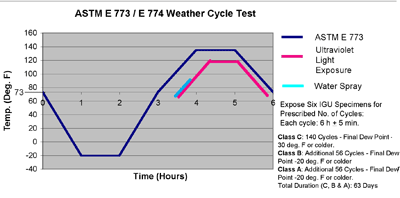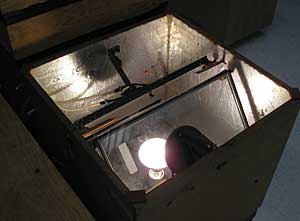The Power of Certified & Tested Insulating Glass Units
Accelerated Weather Cycling
This test is used to simulate weather cycling from hot to cold extremes with moisture added during the hot cycle. The cycling boxes are essentially the same for all three methods. However, both ASTM E 2190 and E 773 have UV radiation during cycling. The CGSB 12.8 test has no UV. As noted previously, ASTM E 2190 and E 773 are required to test the same units in both the high humidity and accelerated weather cycling, while CGSB 12.8 allows separate samples for each test. CGSB 12.8 has more cycles (320 versus 252) but the cycles are of shorter duration than ASTM E 2190 and E 773 (63 days versus 53.3 days). The criterion for passing this test is a frost point of -40°C for both ASTM E 2190 and CGSB 12.8. For E 773, the criterion is warmer, -20° C.
 |
 |
| Scientific testing procedures are part of the standard's requirements. |
Volatile Fog Test
This test is used to show that the components in an insulating glass unit will not out-gas a volatile fog, which could result in a deposit on the interior glass surfaces. All three tests use UV radiation and elevated temperatures to accelerate the effects. ASTM E 1887 has a slightly higher UV output than ASTM E 2190 or CGSB 12.8, but it does not place the test samples in a box. In ASTM E 1887 only one corner of the sample sees the UV radiation and elevated temperature. ASTM E 2190 and CGSB 12.8 uses a temperature that is 10°C higher than ASTM E 774 (60 versus 50° C). However, ASTM E 2190 uses stricter evaluation criteria for viewing the fog. ASTM E 2190 has the observer view the fog at any angle with the sample at arms length. CGSB 12.8 uses a complicated viewing box with the observer at 2 m from the sample looking "normal" to the glass surface.
 |
| This test shows that insulating glass unit components will not out-gas a volatile fog. |
Argon and Krypton Certification
Since 1997, IGMA has offered certification for initial gas fill such as argon and krypton in addition to the conventional durability certification testing to the ASTM E 2190 specification.
To participate in this part of the IGMA Certification Program, the insulating glass manufacturer must gas fill all test samples and achieve an initial gas fill level of 90%, averaged over 10 test specimens in order to achieve this certification designation. Manufacturers who gas fill and want to mark their insulating glass units as IGMA certified must have completed the initial gas fill certification program requirements. Insulating glass manufacturers who elect to certify to the conventional durability testing only may not mark their units as IGMA certified if they have only achieved the durability testing certification and they gas fill their production units. Much like the conventional durability testing requirements, the manufacturers are being tested on their ability to fill to a known level (90%) creating an apple-to-apple platform for the industry. Insulating glass manufacturer's actual production units may or may not be gas filled to this level. The percentage of gas fill required for a particular IGU is dependent on the thermal performance values the IG manufacturer wants to achieve. Other factors such as the window frame construction materials greatly influence the thermal performance of fenestration products.









